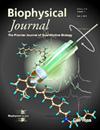Interplay of Protein Fluctuation and Associated Water Dynamics in Osmolyte Induced Stabilization.
IF 3.2
3区 生物学
Q2 BIOPHYSICS
引用次数: 0
Abstract
The mechanism behind osmolyte-induced protein stabilization remains elusive despite extensive research. Amongst various hypotheses, the associated water modulation hypothesis has proven to be the most effective in explaining osmolyte-induced stabilization effects. Earlier we had demonstrated that osmolytes that slow down associated water dynamics enhance protein thermal stability, whereas those that accelerate it, promote destabilization. However, the molecular basis of this correlation remains unclear. Using fluorescence correlation spectroscopy, we observe that osmolyte-induced changes in the associated water dynamics directly affect the internal flexibility of the protein, which is assessed through conformational fluctuation dynamics, serving as a tool to measure the protein's internal flexibility. The osmolytes that induce retardation in the associated water dynamics make the interior of the protein less flexible, as reflected by the slowed conformational fluctuation dynamics of the protein, leading to enhanced thermal stabilization. The destabilizers induce effects that are exactly opposite to stabilizers. These findings provide new insights into the interplay of associated water dynamics, protein flexibility, and stability, contributing to a deeper understanding of osmolyte induced protein stabilization.渗透液诱导稳定化过程中蛋白质波动和相关水动力学的相互作用。
渗透物诱导的蛋白质稳定的机制尽管有广泛的研究,但仍然难以捉摸。在各种假说中,相关的水调制假说已被证明是最有效的解释渗透物诱导的稳定效应。先前我们已经证明,减缓相关水动力学的渗透物增强了蛋白质的热稳定性,而加速它的渗透物则促进了蛋白质的不稳定性。然而,这种相关性的分子基础尚不清楚。利用荧光相关光谱,我们观察到渗透引起的相关水动力学的变化直接影响蛋白质的内部柔韧性,这是通过构象波动动力学来评估的,作为测量蛋白质内部柔韧性的工具。在相关的水动力学中引起延迟的渗透物使蛋白质的内部不那么灵活,这反映在蛋白质的构象波动动力学减慢上,从而导致增强的热稳定性。不稳定因素引起的影响与稳定因素完全相反。这些发现为相关水动力学、蛋白质柔韧性和稳定性的相互作用提供了新的见解,有助于更深入地了解渗透液诱导的蛋白质稳定性。
本文章由计算机程序翻译,如有差异,请以英文原文为准。
求助全文
约1分钟内获得全文
求助全文
来源期刊

Biophysical journal
生物-生物物理
CiteScore
6.10
自引率
5.90%
发文量
3090
审稿时长
2 months
期刊介绍:
BJ publishes original articles, letters, and perspectives on important problems in modern biophysics. The papers should be written so as to be of interest to a broad community of biophysicists. BJ welcomes experimental studies that employ quantitative physical approaches for the study of biological systems, including or spanning scales from molecule to whole organism. Experimental studies of a purely descriptive or phenomenological nature, with no theoretical or mechanistic underpinning, are not appropriate for publication in BJ. Theoretical studies should offer new insights into the understanding ofexperimental results or suggest new experimentally testable hypotheses. Articles reporting significant methodological or technological advances, which have potential to open new areas of biophysical investigation, are also suitable for publication in BJ. Papers describing improvements in accuracy or speed of existing methods or extra detail within methods described previously are not suitable for BJ.
 求助内容:
求助内容: 应助结果提醒方式:
应助结果提醒方式:


